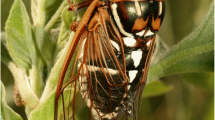Abstract
Males of most bushcricket species produce acoustic advertisement signals to attract females for mating. These signals can also increase conspicuousness to predators. In the genus Poecilimon (Orthoptera: Phaneropterinae) males are attacked by the parasitoid fly Therobia leonidei (Diptera: Tachinidae: Ormiini) which locates males by their calls. In Greece T.leonidei parasitizes several Poecilimon species with different song structures: we examined whether host choice is related to song structure by comparing parasitism rates in two closely related Poecilimon species. One of these species produces monosyllabic songs, the songs of the other species being polysyllabic. The tachinid fly parasitized the polysyllabic species to a greater extent. We demonstrate in a field-experiment that this preference for the polysyllabic species does not depend on local adaptations of the fly. The most probable explanation for the preference of the fly for the polysyllabic singing species seems to be better detection of longer songs. This result is discussed in the context of male song evolution.
Similar content being viewed by others
Author information
Authors and Affiliations
Additional information
Received: 4 November 1997 / Accepted after revision: 22 March 1998
Rights and permissions
About this article
Cite this article
Lehmann, G., Heller, KG. Bushcricket song structure and predation by the acoustically orienting parasitoid fly Therobia leonidei (Diptera: Tachinidae: Ormiini). Behav Ecol Sociobiol 43, 239–245 (1998). https://doi.org/10.1007/s002650050488
Issue Date:
DOI: https://doi.org/10.1007/s002650050488




